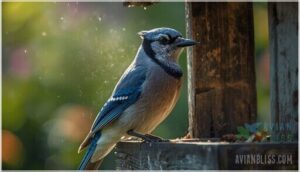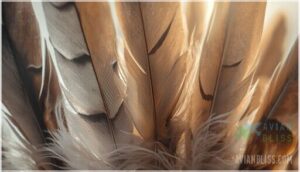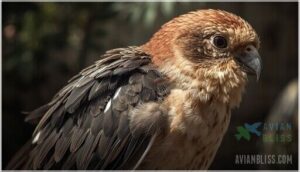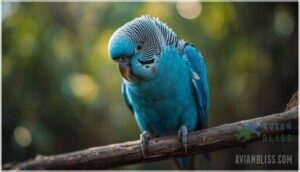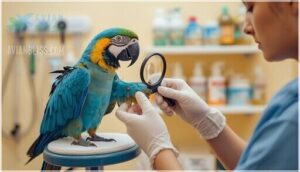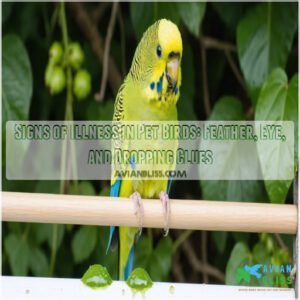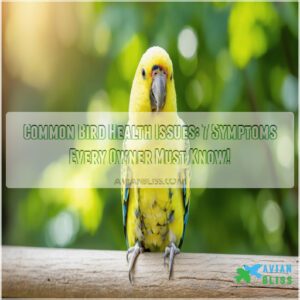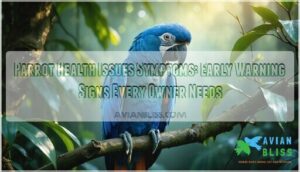This site is supported by our readers. We may earn a commission, at no cost to you, if you purchase through links.
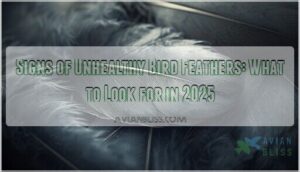
Dull coloring, stress bars, or unusual breakage patterns signal problems that happened weeks or even months ago. Understanding these signs lets you catch health issues before they become emergencies and gives your veterinarian important clues about what’s affecting your bird.
Recognizing the difference between normal wear and genuine health concerns can mean the difference between a minor diet adjustment and a life-threatening condition.
Table Of Contents
- Key Takeaways
- Feather Structure Basics
- Unhealthy Feather Signs
- Causes of Unhealthy Feathers
- Identifying Bird Illness
- Addressing Feather Problems
- Frequently Asked Questions (FAQs)
- What are the most common health problems seen in pet birds?
- Why do parrots have bad feathers?
- How do you know if a bird has feather loss?
- How do I know if my bird’s feathers are healthy?
- Why does my bird’s feathers look bad?
- Can a bird lose feathers?
- What do unhealthy bird feathers look like?
- What are the symptoms of feather disease?
- How do I know if my bird is unhealthy?
- Why are my bird’s feathers messed up?
- Conclusion
Key Takeaways
- Feathers act as a medical record, capturing nutritional deficiencies, stress events, and illnesses through visible signs like dull coloring, stress bars, and abnormal breakage patterns that occurred weeks or months earlier.
- Unhealthy feathers stem from identifiable causes, including protein and amino acid deficiencies (feathers are 90% protein), viral infections like PBFD affecting 16% of parrots globally, hormonal imbalances causing 20-30% of chronic feather problems, and compromised oil glands that fail to waterproof plumage.
- Early warning signs require immediate veterinary attention when you notice persistent dullness, horizontal stress bars indicating interrupted keratin synthesis, feather plucking affecting up to 30% of captive birds, or abnormal molting patterns that appear outside regular seasonal cycles.
- Effective treatment combines professional avian veterinary diagnostics (60-70% accuracy in identifying root causes), nutritional adjustments with high-protein recovery formulas that accelerate regeneration by 40%, environmental improvements, including 50-60% humidity and enrichment activities, and ruling out parasites through microscopic analysis before assuming dietary causes alone.
Feather Structure Basics
Before you can spot trouble with your bird’s feathers, you need to understand what healthy feathers look like from the inside out. Each feather is a marvel of natural engineering, built from specific components that work together to keep your bird warm, dry, and flight-ready.
Let’s break down the three essential parts that make up every feather on your bird’s body.
Keratin Composition
Keratin makes up the foundation of every feather on your bird’s body. This resilient protein structure contains about 54% β-sheets and 32% α-helices, giving feathers their strength and flexibility. The molecular bonds between amino acids—especially cysteine’s disulfide bridges—create a lightweight yet incredibly durable framework that resists environmental damage.
Here’s what keratin does for your bird:
- Creates structural integrity through tightly woven protein folding
- Provides water resistance and insulation for temperature control
- Facilitates self-repair during normal preening and maintenance
- Promotes rapid feather growth during molting cycles
- Protects against bacterial breakdown and physical wear
This protein structure is why healthy feathers stay strong, colorful, and functional throughout your bird’s life. Understanding the bird keratin structure is essential for appreciating the complexity of bird feathers.
Central Shaft and Branches
Looking at feather anatomy, you’ll notice the rachis—the central shaft running through each feather—gives structural backbone to the entire design. Its diameter usually ranges between 0.2 and 0.5 units along its length, with the cortex thickness adapting based on your bird’s flight style.
Barbs branch off the rachis at about 8 to 14 per millimeter, each connected by tiny barbules spaced 8 to 16 micrometers apart. These microscopic hooks create the smooth, flexible surface you see.
When examining shaft health, check for hollowness in the medulla—that spongy core provides strength without weight, vital for flight and feather flexibility. Understanding the role of feather development is essential for recognizing healthy feather growth.
Follicles and Calamus
Beneath the rachis lies the calamus—the hollow, translucent base anchoring each feather within its follicle. These follicles are living pockets in your bird’s skin, packed with nerve fibers and blood vessels that support feather regrowth during molting patterns. Think of them as miniature factories cycling through growth and rest phases driven by stem cells.
When follicle health falters—whether from avian dermatology issues or follicle diseases like PBFDV—you’ll see calamus structure break down: thinning walls, blood inside the shaft, or retained sheaths clinging stubbornly to new keratin growth.
- Healthy follicles anchor feathers firmly and regulate normal molt cycles
- Calamus abnormalities signal underlying follicular dysfunction or viral insult
- Compromised feather anatomy disrupts flight, warmth, and overall plumage integrity
Unhealthy Feather Signs
Now that you understand how feathers are built, you need to know when something’s gone wrong. Your bird’s plumage acts like a health report card, and certain warning signs shouldn’t be ignored.
Here are the key red flags that indicate your bird’s feathers aren’t as healthy as they should be.
Dull Feathers
When your bird’s feathers lose their shine, it’s often the first visible clue that something’s off beneath the surface. Dull feathers signal nutrition deficits, especially lacking protein-rich amino acids like methionine, which can fade feather coloration and roughen feather texture.
Environmental factors matter too—pollutant effects from urban air can strip vibrancy from plumage.
Poor feather health reflects your bird’s overall condition, so don’t ignore lackluster feather appearance or compromised feather structure.
Stress Bars and Breakage
Horizontal lines crossing your bird’s feathers aren’t just cosmetic flaws—they’re visible proof of past trauma. Stress bars form when keratin synthesis stops mid-growth, creating weak spots that snap easily under flight pressure. Research shows these fault bars reduce rachis strength by up to 30%, turning once-sturdy feathers into fragile structures prone to breakage patterns.
Stress bars—horizontal lines across feathers—reveal past trauma, creating weak spots that reduce rachis strength by 30% and cause breakage
Watch for these warning signs of feather damage:
- Multiple bars appearing simultaneously across wing feathers, indicating a specific stress event during molt
- Fractures originating at stress bar sites, where the rachis literally breaks apart under normal use
- Repeating bars across successive molts, suggesting chronic nutritional deficits or ongoing environmental stressors
These feather fractures don’t heal—they’re permanent records of your bird’s struggles with diet gaps, handling stress, or illness during feather growth.
Feather Breakage
Fractures along the feather shaft tell a story your bird can’t voice. Feather breakage often stems from nutritional gaps—methionine deficiency alone cuts growth rates by up to 28% and creates brittleness in over 90% of affected birds.
You’ll spot breakage patterns at weak points where disulfide bonds have failed, reducing tensile strength by nearly half.
These molting issues compromise flight efficiency and insulation, signaling deeper feather health issues that demand immediate attention before beak damage or self-mutilation follows.
Self-inflicted Damage
Watch for feather plucking, feather picking, or self-mutilation—these aren’t quirks but serious distress signals. Studies show feather destructive behavior affects up to 30.6% of captive cockatoos and signals profound psychological or physical problems.
Self-inflicted feather damage includes:
- Bare patches from repetitive feather plucking
- Broken shafts from compulsive beak trimming
- Frayed feather breakage from over-preening
These feather problems demand immediate veterinary attention, as your bird’s trying to tell you something’s deeply wrong.
Abnormal Molting Patterns
Patchy feather loss, extended molt duration, or incomplete replacement during typical molting cycles—these aren’t normal and deserve your attention. Studies confirm abnormal molting patterns affect over 8% of birds, often tied to infections, nutritional gaps, or environmental stress. You might notice asymmetrical regrowth, bare patches appearing outside regular molting seasons, or feathers that never fully develop.
Young birds show higher vulnerability at 22.5% prevalence compared to adults at 4.5%. These molting disorders strain avian health markedly, increasing metabolic demands by up to 82% and leaving your bird exposed to temperature extremes and compromised feather health.
Causes of Unhealthy Feathers
When your bird’s feathers start looking off, there’s always a reason behind it. Understanding what causes these changes helps you catch problems early and get your feathered friend the care they need.
Let’s look at the main culprits that can affect your bird’s plumage.
Nutritional Deficiencies
Protein Deficiency sits at the heart of most feather problems, since feathers are nearly 90% protein. Without enough amino acids like methionine and lysine, your bird’s plumage loses its structural integrity, leading to breakage and poor growth.
Vitamin Imbalance—especially low vitamin A—triggers dull coloration and weakened keratin, while Mineral Defects such as zinc shortages produce frayed, spoon-shaped feathers.
Here’s what malnutrition commonly causes:
- Stress bars (dark horizontal lines) from vitamin or protein gaps
- Depigmentation and shortened shafts from iron or selenium deficiency
- Brittle, lackluster feathers from Fatty Acid Issues, particularly omega-3 deficits
Balanced nutrition is your best defense against these preventable feather health disasters.
Infections and Toxins
Viral Infections like beak and feather disease virus hit 16% of parrots globally, causing follicle destruction and catastrophic feather loss.
Bacterial Exposure accelerates wear through biofilm formation, while Fungal Contamination—found in nearly 19% of surveyed birds—triggers breakage and discoloration.
Environmental Pollutants including cadmium and lead accumulate in feathers, disrupting growth cycles. Toxin Accumulation from pesticides creates visible stress markers, signaling systemic damage that demands immediate veterinary attention.
Hormonal Imbalances
Beyond infections and toxins, hormonal imbalances throw your bird’s entire feather system out of sync. Thyroid effects like hypothyroidism cause visible feather loss and ruffled plumage, while elevated corticosterone from chronic stress weakens keratin integrity by 32%. Sex steroids alter feather morphology during breeding, and disrupted prolactin role delays molt cycles by weeks.
Key hormonal disorders affecting feather health include:
- Hypothyroidism reducing metabolic function and feather quality
- Chronic stress elevating corticosterone and creating brittle feathers
- Testosterone surges causing structural weakness despite increased length
- Prolactin imbalances disrupting normal molt synchronization
These endocrine disruptions account for 20–30% of chronic feather problems in captive parrots, making veterinary hormone therapy essential for restoration.
Skin and Oil Gland Conditions
Your bird’s uropygial gland produces oils that waterproof feathers and fight bacterial growth. When this gland becomes blocked or infected—often due to vitamin A deficiency or trauma—oil production stops entirely, leaving feathers vulnerable. You might notice swelling above the tail base or dull feather appearance.
Bacterial skin infections, commonly from Staphylococcus species, create ulcerated lesions that damage feather follicles and cause patchy loss. Feather cysts form when keratin builds beneath the skin instead of emerging properly, affecting follicles permanently. These gland disorders and skin conditions directly compromise feather health and require veterinary attention to restore normal function.
Identifying Bird Illness
When feathers start looking off, they’re often just the tip of the iceberg. Your bird’s entire body might be trying to tell you something’s wrong, and catching those signs early can make all the difference.
Let’s walk through the key warning signs that indicate your feathered friend needs attention.
Changes in Feather Appearance
Your bird’s feather appearance tells a story about their health. Dull feathers lacking their normal shine often indicate nutritional deficiencies, particularly vitamin A or essential fatty acids, affecting up to 65% of captive birds under veterinary care. Feather color shifts, like yellowing in white areas, can signal liver problems.
Poor plumage quality, including frayed edges or altered feather texture, points to chronic stress or malnutrition. Stress bars—those telltale horizontal lines—appear in over 60% of birds experiencing recent trauma.
Changes in feather luster and abnormal molting patterns are your early warning system, revealing underlying issues before they become serious.
Physical and Behavioral Changes
You’ll notice physical and behavioral changes alongside feather loss. Lethargy signs appear in up to 65% of affected birds, who may rest over 60% of the day instead of engaging normally. Watch for reduced activity—your once-active companion might show a 30–40% drop in movement.
Social withdrawal becomes obvious when birds avoid interaction or display a 50% spike in defensive behavior.
Pain indicators include excessive scratching, rubbing, and feather destructive behavior, with discomfort preceding plucking episodes in 88% of documented cases. These stress behaviors and signs of unhealthy feathers signal that something’s affecting your bird’s well-being beyond just feather damage.
Respiratory and Eye Changes
Watch for labored breathing or tail bobbing—these respiratory distress symptoms occur in over 70% of birds with lower respiratory tract disease. Eye infections manifest as discharge, swelling, or crusting around the eyelids.
Mycoplasmal conjunctivitis affects 19% of feeder bird populations annually, while wheezing and breathing problems often accompany fungal infections like aspergillosis.
If you notice persistent respiratory issues or ocular changes, contact your avian veterinarian immediately.
Feeding and Elimination Changes
Often, appetite changes appear before physical symptoms become obvious—loss of appetite is spotted in over 70% of avian veterinary cases. Monitor your bird’s feeding behavior closely, noting reduced food intake or sudden hyperphagia.
Changes in droppings reveal digestive health quickly: healthy parrots defecate every 15–20 minutes, so reduced dropping frequency signals dehydration or blockage. Normal droppings contain dark feces, white urates, and clear urine—deviations like black tar-like feces, bright green coloration, or watery consistency indicate digestive issues ranging from bacterial infections to liver dysfunction.
Nutritional deficiencies directly affect elimination patterns and feather health and wellness, making these observations critical.
Addressing Feather Problems
Once you’ve spotted unhealthy feathers, the next step is getting your bird back on track. Effective treatment involves a combination of professional veterinary care, environmental improvements, and ongoing monitoring.
Here’s what you need to know about addressing feather problems and supporting your bird’s recovery.
Veterinary Examination
When feathers lose their shine or texture, your avian veterinarian can pinpoint what’s going wrong. A thorough veterinary examination becomes the diagnostic cornerstone, accounting for 60–70% of accuracy in identifying feather problems. Your vet will document body weight, assess plumage quality, and inspect skin conditions using Medical Imaging and specialized Diagnostic Tests. This thorough Feather Analysis helps catch issues early—from nutritional gaps to infections—before they compromise your bird’s health.
Avian Specialists rely on evidence-based protocols to separate behavioral quirks from true medical concerns:
- Detailed feather structure evaluation
- Skin and follicle inspection for lesions
- Blood work to detect systemic imbalances
- Microbial cultures identifying infections
- Photographic tracking of feather health progression
Early Veterinary Care transforms small signs into manageable solutions.
Diet Adjustments and Environment
Your bird’s feathers mirror what’s on the menu—diets low in protein or lacking methionine can trigger breakage and dull coloration. Balanced bird nutrition centered on pellets, fresh vegetables, and adequate amino acids resolves nutritional deficiencies directly.
Environmental factors matter too: maintain 50–60% humidity, provide natural perches for enrichment, and offer bathing opportunities.
These diet adjustments and environment tweaks support feather health by ensuring nutritional balance, promoting Avian Nutrition, and creating conditions that encourage vibrant plumage through proper Dietary Enrichment and Feather Supplements when warranted.
Ruling Out Parasites
Before you blame diet alone, you’ll need to rule out parasites—these hidden troublemakers can mimic nutritional deficiencies. Diagnostic Testing through Avian Laboratories helps detect parasitic mites and feather lice with fecal exams and microscopic analysis. Watch for these warning signs suggesting Parasite Detection is needed:
- Rough, matted feathers around the vent
- Persistent scratching or restlessness
- Bald patches with visible skin lesions
Proper Parasite Prevention starts with thorough veterinary diagnostics to exclude these causes of feather damage.
Supportive Care and Rehabilitation
Think of rehabilitation as rebuilding a house from the foundation up—you can’t skip steps and expect it to stand strong. Once parasites are ruled out, your bird needs thorough supportive care and rehabilitation.
Start with nutritional support using high-protein recovery formulas that accelerate feather regeneration by up to 40%. Physical therapy and enrichment strategies—like varied perches and foraging toys—reduce stress-related plucking by 60%. For severe damage, feather imping replaces broken feathers, restoring flight within days.
Stress management is essential: maintain temperatures around 85–90°F and provide a quiet recovery space. This integrated approach to avian rehabilitation combines diet, environmental modifications, and veterinary oversight to support complete feather recovery and long-term health.
Frequently Asked Questions (FAQs)
What are the most common health problems seen in pet birds?
Around 11% of pet birds engage in feather destructive behavior, with respiratory diseases, nutritional deficiencies, and infectious diseases like psittacosis topping the list.
You’ll notice signs of unhealthy bird feathers through dull plumage or stress bars.
Why do parrots have bad feathers?
Nutritional deficiencies—especially vitamin A, calcium, and essential amino acids—top the list when feathers look shabby.
Environmental stressors like low humidity and cramped cages trigger feather plucking in up to 30% of captive parrots.
Parasitic infestations, PBFD prevalence, and hormonal imbalances also cause significant feather damage.
How do you know if a bird has feather loss?
Feather loss in birds shows up as bald patches, visible skin, or asymmetrical feather distribution across the body. You’ll notice broken feathers, dull plumage, or areas where feathers seem thinner than normal.
Behavioral signs matter too—watch for excessive preening or plucking.
How do I know if my bird’s feathers are healthy?
Your bird’s feathers are like polished armor—when healthy, they radiate with a glossy sheen and lie smooth against the body.
Check for vibrant alignment, symmetrical molting patterns, and active preening habits, which signal strong structural integrity and excellent feather condition free from unhealthy signs.
Why does my bird’s feathers look bad?
When feathers look off—dull, ragged, or sparse—you’re often seeing underlying health issues at play.
Poor feather health generally stems from nutritional deficiencies, infections, stress, or environmental factors that disrupt normal growth and maintenance patterns.
Can a bird lose feathers?
Yes, feather loss happens naturally through molting. Most birds molt once or twice yearly, with smaller species completing the process in weeks while larger ones take months.
Abnormal loss from infections, nutritional deficiencies, or parasites requires veterinary attention for proper diagnosis and treatment.
What do unhealthy bird feathers look like?
When you spot dull coloration, damaged edges, or disheveled plumage, you’re seeing signs of unhealthy bird feathers.
Watch for stress bars, bald patches, feather breakage, fluffed feathers, and messy plumage—all indicating underlying health concerns.
What are the symptoms of feather disease?
When symptoms of feather disease appear, you’ll notice progressive dystrophy—feathers become malformed, brittle, and lose their natural luster. Abnormal molting accelerates, creating patchy feather loss and structural defects that worsen with each cycle, often signaling serious underlying health concerns.
How do I know if my bird is unhealthy?
Studies show that up to 40% of captive birds display health problems before owners notice.
Watch for lethargy, reduced activity levels, dull feathers, drooping wings, abnormal droppings, breathing changes, or decreased appetite—these early signs and behavior changes signal it’s time for an avian vet visit.
Why are my bird’s feathers messed up?
Your bird’s feathers can look messed up from poor nutrition, stress, hormonal imbalances, or infections—all common causes of unhealthy bird feathers.
Environmental stressors, behavioral issues like plucking, molting complications, and genetic predisposition also contribute to feather damage and feather problems requiring veterinary attention.
Conclusion
Don’t ruffle your own feathers over every imperfection—context matters. Normal wear from perching differs vastly from signs unhealthy bird feathers problems reveal.
When you spot persistent dullness, stress bars, or unusual molting, your bird’s body is telling a story that deserves attention. Trust your instincts, document what you observe, and partner with an avian vet to decode the message. Your vigilance transforms those tiny warning signals into actionable care.
- https://www.harrisonsbirdfoods.com/signs-info/
- https://pmc.ncbi.nlm.nih.gov/articles/PMC8279392/
- https://birdsupplies.com/blogs/news/bird-stress-bars-a-simple-guide-to-healthy-feathers
- https://www.delawarenaturesociety.org/wp-content/uploads/2021/10/Stewart-and-Sebastiani.-2019.-Feather-mites..pdf
- https://www.sciencedirect.com/science/article/pii/S0001706X23002577

